The sculpture “Humanity Against Evil”, carved by renowned Italian sculptor Gaetano Cellini, stands as a striking symbol of resilience and the triumph of good over malevolence. Displayed at the National Gallery of Modern Art in Rome, this masterpiece is not only a testament to Cellini’s artistic brilliance but also an evocative representation of human struggle and hope. Follow archeology.dulichvn.net to discover many hidden mysteries that have yet to be discovered.
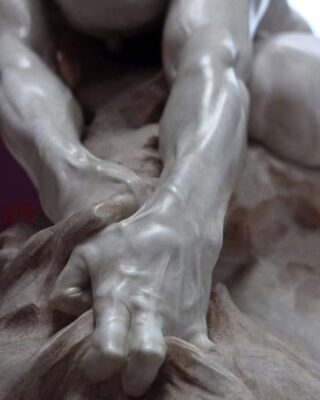
The Creation of a Masterpiece
The Vision Behind “Humanity Against Evil”
Gaetano Cellini’s “Humanity Against Evil” is a profound artistic statement, capturing the eternal struggle of humanity against the forces of oppression, corruption, and moral decay. Through this masterpiece, Cellini sought to convey a universal message of resilience and hope that transcends cultural, temporal, and geographical boundaries.
The sculpture serves as a visual allegory, depicting humanity’s inner and external battles against malevolence. By portraying figures caught in the throes of struggle yet imbued with unyielding determination, Cellini emphasizes the timeless nature of this conflict. The interplay of light and shadow across the sculpture further deepens its emotional resonance, drawing viewers into the tension between despair and hope.
The Material: Marble’s Timeless Elegance
Carved from a single block of pristine white marble, “Humanity Against Evil” exemplifies Cellini’s unparalleled mastery of this revered material. Marble, often associated with purity and immortality, was the perfect medium to encapsulate the moral and spiritual dimensions of the sculpture. Its luminous surface captures and reflects light, imbuing the figures with a dynamic quality that seems to shift and evolve as viewers move around it.
The cold, smooth texture of the marble contrasts starkly with the intense emotions portrayed, amplifying the tension within the work. The choice of marble also speaks to the timeless relevance of the themes Cellini explored—an eternal struggle rendered in a medium that itself defies the ravages of time.
A Work of Precision and Emotion
“Humanity Against Evil” is a testament to Cellini’s technical expertise and his ability to infuse stone with profound emotion. Every aspect of the sculpture, from the anguished expressions etched onto the human faces to the sinuous, almost serpentine patterns representing evil’s grip, is rendered with painstaking precision.
The human figures are depicted in various states of struggle, their muscles taut with effort, their faces etched with both fear and defiance. These elements bring a visceral quality to the sculpture, allowing viewers to feel the intensity of the conflict as if they were participants themselves.
Cellini’s intricate detailing extends to the malevolent forms entwined around the figures, embodying evil as a pervasive and insidious force. This juxtaposition of human resilience against the creeping presence of darkness creates a powerful narrative that resonates deeply with viewers, making the sculpture not just a visual marvel but an emotional experience.
Through his expert craftsmanship and visionary artistry, Cellini transformed marble into a living story—one that continues to inspire awe and introspection in all who encounter it.
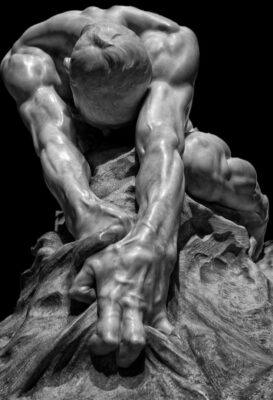
Symbolism and Themes in “Humanity Against Evil”
The Struggle of Good Versus Evil
At the core of “Humanity Against Evil” lies a timeless narrative: the unyielding battle between the forces of good and evil. Gaetano Cellini masterfully brings this eternal conflict to life by portraying human figures locked in a desperate struggle against a monstrous, serpentine entity. This grotesque form embodies malevolence, its tendrils wrapping around the figures in an attempt to ensnare them.
The tension in the composition is palpable, with every muscle, gesture, and expression meticulously sculpted to convey both the physical and emotional weight of the confrontation. Despite being outmatched, the human figures refuse to yield, their determination symbolizing the indomitable human spirit. This dynamic interplay between light and darkness captures the essence of humanity’s relentless fight to overcome adversity and moral corruption.
A Universal Message
“Humanity Against Evil” transcends the boundaries of culture, language, and time, speaking to a universal human experience. The sculpture’s themes are as relevant today as they were in Cellini’s era, reflecting struggles faced by individuals and societies worldwide. Whether it’s overcoming personal demons, fighting systemic injustice, or confronting global crises, the piece resonates deeply with all who encounter it.
The Italian origins of the sculpture are just a backdrop to its broader appeal. Its message is one of unity and shared resilience, reminding viewers that the fight against evil is a collective endeavor. By portraying humanity’s courage and moral strength, Cellini’s work serves as a beacon of hope, inspiring audiences to stand firm in the face of life’s challenges.
Hope and Resilience
While the sculpture vividly depicts the harrowing struggle against evil, it ultimately radiates a profound sense of hope. The upward gazes of the human figures suggest a connection to something greater—a divine or moral force that guides and empowers them. Their defiant postures and unwavering resolve convey the belief that, no matter how insurmountable the odds, good has the capacity to triumph over darkness.
The juxtaposition of anguish and hope within the work invites viewers to reflect on their own resilience. The tension captured in the marble is not just a depiction of struggle but a celebration of humanity’s capacity to endure and rise above challenges. Through “Humanity Against Evil”, Cellini reminds us that even in the darkest moments, the light of hope and the strength of the human spirit remain unbreakable.
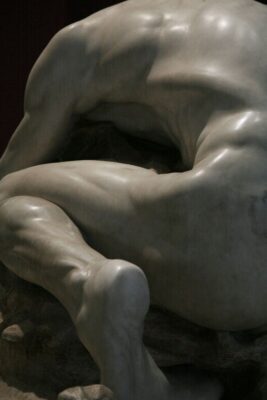
Legacy and Significance
Gaetano Cellini’s Artistic Brilliance
“Humanity Against Evil” represents the pinnacle of Gaetano Cellini’s artistic prowess, solidifying his reputation as one of the most influential sculptors of the modern era. In this masterpiece, Cellini masterfully combines technical perfection with profound emotional depth, creating a work that transcends mere visual appeal to touch the hearts and minds of all who behold it.
The sculpture showcases Cellini’s unparalleled ability to convey complex themes through the medium of marble. Every curve, detail, and contour reflects his dedication to his craft, while the dynamic interplay of light and shadow brings the piece to life. His ability to blend realism with symbolism ensures that “Humanity Against Evil” resonates as both a technical marvel and a deeply moving narrative.
A Highlight of the National Gallery of Modern Art
Housed within the prestigious National Gallery of Modern Art in Rome, “Humanity Against Evil” holds a place of honor among the museum’s extensive collection. As one of its most iconic pieces, the sculpture draws visitors from across the globe, eager to experience its raw power and intricate craftsmanship firsthand.
The placement of the sculpture within the gallery allows viewers to fully appreciate its grandeur. The museum’s carefully curated lighting enhances the marble’s natural beauty, highlighting the intricate details and emotional intensity of the piece. It serves not only as a testament to Cellini’s genius but also as a cornerstone of the gallery’s mission to preserve and celebrate groundbreaking works of modern art.
A Timeless Inspiration
Even decades after its creation, “Humanity Against Evil” continues to inspire and captivate audiences. Artists and sculptors draw from Cellini’s mastery of form and emotion, while scholars analyze its intricate symbolism and historical context. Visitors, regardless of their background, find themselves moved by its universal themes of resilience, hope, and the eternal struggle between good and evil.
The sculpture’s enduring relevance lies in its ability to speak to the human condition. As a work that bridges the gap between personal introspection and collective experience, it remains a source of inspiration for generations. Its place in both Italian cultural heritage and the global art world ensures that “Humanity Against Evil” will continue to be celebrated as a monumental achievement in sculpture, a timeless reminder of the enduring power of art to move and transform.
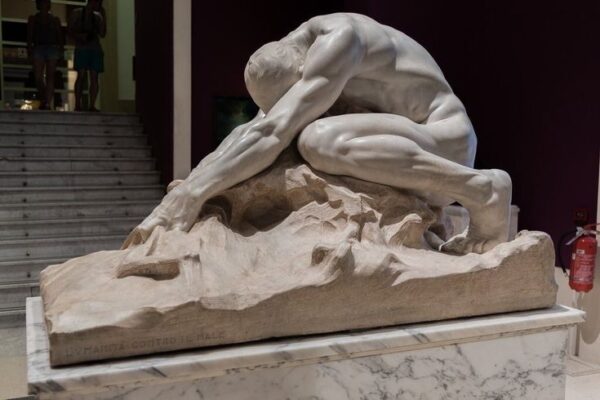
See more: The Walls of Constantinople in the 1950s: A Historical Perspective
Conclusion
“Humanity Against Evil” by Gaetano Cellini is more than just a sculpture; it is a profound exploration of human resilience and moral triumph. Carved from marble with unmatched skill, the piece remains an iconic feature of the National Gallery of Modern Art in Rome. Through its universal message of hope and the triumph of good, this masterpiece continues to resonate with audiences, reminding us of the enduring power of humanity against adversity.

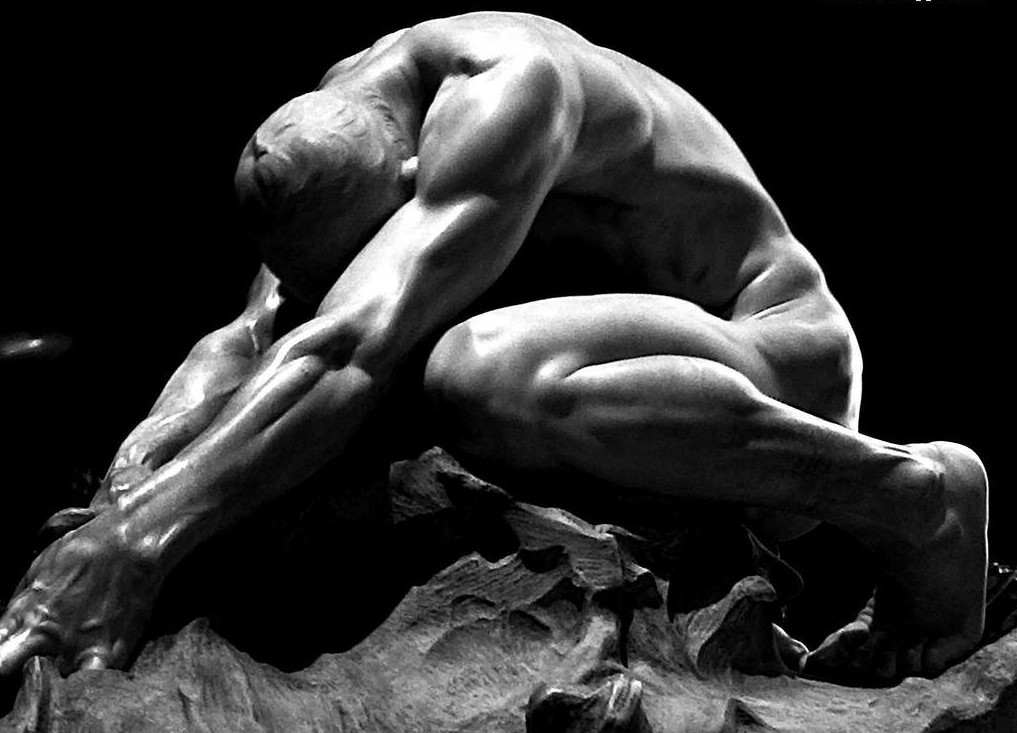
CÁC TIN KHÁC
Mary Walton: The Forgotten Inventor Who Helped Clean Up America’s Cities
Tomb of Queen Nefertari in the Valley of the Queens, Egypt
Discover the Hypostyle Hall of the Temple of Hathor at Dendera
Venus de Losange: Unveiling the Mystery of a 20,000-Year-Old Paleolithic Icon